What is Annual Recurring Revenue (ARR) & how to calculate ARR

What is Annual Recurring Revenue (ARR)?
Annual Recurring Revenue (ARR) is the predictable and recurring revenue a company expects to generate annually from subscription-based customers.
In other words, Annual Recurring Revenue (ARR) measures a company's predictable, ongoing revenue, normalized over one year. It includes only recurring revenue, such as from subscriptions or contracts, excluding one-time payments or non-renewable fees. ARR is important for businesses operating on a subscription basis.
For example, if a subscriber purchases a 3-year subscription to a cloud storage solution for $30,000, the annual recurring revenue would be $10,000.
Businesses can increase their ARR by leveraging upsells, expanding market reach, cutting acquisition costs, and enhancing customer retention efforts. Companies can also consider adding avenues of customer engagement, such asin-app chat, calls, AI chatbots, and business messaging, into their apps for a richer customer experience. This would fuel engagement, customer satisfaction, and, therefore, retention.
How to calculate ARR
The following is the annual recurring revenue formula:
ARR = [Total dollar amount of subscriptions + Total dollar amount from additional ongoing revenue such as add-ons and upgrades] - Revenue lost from cancellations and downgrades
What do these mean?
Total dollar amount of subscriptions: This is the total amount of subscription money customers pay every year.
Total dollar amount from additional ongoing revenue: This is the total amount of money that comes from add-ons and upgrades (which is not included in #1 above).
Revenue lost from cancellations and downgrades: This is the money lost due to customer churn and downsell.
You must only calculate recurring and lost revenue that spans a year. Most one-time fees, adjustments, and add-ons shouldn’t be included in this metric if you want to keep your ARR calculation highly accurate and indicative of your company’s direction. Just as critical, you must be consistent with your ARR formula from year to year.
Another way to calculate the annual recurring revenue is simply to multiply the monthly recurring revenue by 12. (ARR = MRR x 12)
What you should not include in your ARR calculation
In your ARR calculation, it's important to exclude certain types of revenue to ensure that ARR accurately reflects stable, predictable income from subscriptions only. Here are the types of revenue you should not include in your ARR calculation:
One-time charges: Exclude any fees that are non-recurring, such as setup fees, one-time service fees, or implementation fees. These do not reflect ongoing customer commitments.
Non-recurring revenue: This can include revenue from short-term contracts that aren’t expected to renew automatically or contractual services that do not recur yearly.
Variable usage fees: While some SaaS models include usage-based pricing, these fees should only be included in ARR if they are predictable and recur with each contract period. Highly variable or unpredictable usage fees should not be counted.
Customization fees: Charges for custom work or additional professional services that are outside the standard subscription agreement should be excluded, as these are generally not repeated with each subscription cycle.
Interest, dividends, or other financial gains: Any income from financial instruments or investments unrelated to the core subscription services should be left out of ARR calculations.
Examples of ARR calculation
Let’s take a look at sample ARR calculations for a fictitious SaaS company.
Example 1: Simple ARR calculation
Scenario: A SaaS company offers a productivity software with two subscription tiers: Basic at $30/month and Pro at $60/month. Additionally, they offer an ongoing add-on for enhanced data security priced at $15/month. Currently, they have 500 Basic subscribers and 300 Pro subscribers. A total of 100 subscribers have opted for the add-on.
Calculation:
- Total dollar amount of subscriptions:
Basic: 500 subscribers x $30/month = $15,000/month
Pro: 300 subscribers x $60/month = $18,000/month
Total dollar amount from subscriptions: $15,000/month + $18,000/month = $33,000/month
- Total dollar amount from additional ongoing revenue:
Add-on: 100 subscribers x $15/month = $1,500/month
- ARR calculation:
ARR = ($33,000 + $1,500) x 12 months = $414,000
In this example, the company's ARR is $414,000, indicating the annualized rate of expected recurring revenue from subscriptions and add-ons.
Example 2: Comprehensive ARR calculation with cancellations and downgrades
Scenario: The same SaaS company as in Example 1 also experienced some cancellations and downgrades over the past year. During the year, they lost 20 Pro subscriptions and 50 Basic subscriptions converted to Pro subscriptions, reducing the revenue from the Basic tier.
Additional data:
Loss from cancellations (20 Pro at $60/month): 20 x $60 = $1,200/month
- Revenue shift from downgrades (50 Basic to Pro, losing $30 from Basic and gaining $60 for Pro):
Loss: 50 x $30 = $1,500/month
Gain: 50 x $60 = 3,000/month
Net gain from downgrades: $3,000 - $1,500 = $1,500/month
ARR calculation:
- Adjusted total from subscriptions (considering net changes):
New Basic revenue: (500 - 50) x $30 = $13,500/month
New Pro revenue including downgrades and minus cancellations: (300 + 50 - 20) x $60 = $19,800/month
Total from adjusted subscriptions: $13,500 + $19,800 = $33,300/month
- Total dollar amount from additional ongoing revenue remains the same:
Add-on: $1,500
- Net ARR Calculation considering loss:
ARR before loss: ($33,300 + $1,500) x 12 = $418,800
Annual loss from cancellations: $1,200 x 12 = $14,400
Final ARR: $418,800 - 14,400 = $404, 400
In this comprehensive example, the adjusted ARR of $404,400 reflects the actual expected annual revenue, accounting for both increases through upgrades and losses through cancellations and downgrades. This provides the product manager with a realistic view of the financial impact of customer movements on the subscription revenue.
Why is annual recurring revenue important? Top 6 reasons to track ARR
In a nutshell, ARR is crucial for assessing a company’s financial health and growth trajectory as it provides insight into the stability and scalability of revenue streams. ARR is a key metric for businesses with recurring revenue or subscription-based models because it measures not only year-over-year growth but also helps to forecast what profits may look like a year (or more) in the future. Product managers can use ARR in forecasting, resource allocation, and strategic planning.
Here are some details about why annual recurring revenue is so important in the subscription economy:
Predictability: Annual recurring revenue offers a predictable view of income, essential for budgeting and financial planning. This predictability allows SaaS companies to manage cash flow effectively and make informed decisions regarding future investments and expenses.
Valuation: Investors frequently use ARR to assess the value of a SaaS company. A higher ARR often indicates a more valuable business, making it an essential metric for attracting investments and supporting business valuations during fundraising or acquisition discussions.
Resource allocation: By understanding ARR, product managers can allocate resources more efficiently, prioritizing projects that are likely to enhance or sustain recurring revenue streams. This strategic allocation directly impacts product development and service improvements.
Performance benchmarking: ARR allows product managers to benchmark their performance against industry standards and competitors. Tracking changes in ARR over time helps assess the impact of strategic decisions and market position.
Customer success tracking: Annual recurring revenue helps in monitoring customer renewals and retention, which are crucial for long-term viability. It indicates the effectiveness of customer success strategies by showing how well the company maintains its recurring revenue base.
Product lifecycle insights: Monitoring ARR changes can provide insights into the product lifecycle and market demand. A rising ARR may indicate product maturity and market acceptance, prompting product managers to explore expansion or scaling strategies. At the same time, a declining ARR might signal the need for product innovation or enhancement. Annual recurring revenue can also evaluate the effectiveness of sales and marketing efforts.
ARR for tech startups: Top 4 aspects of ARR that startups should know about
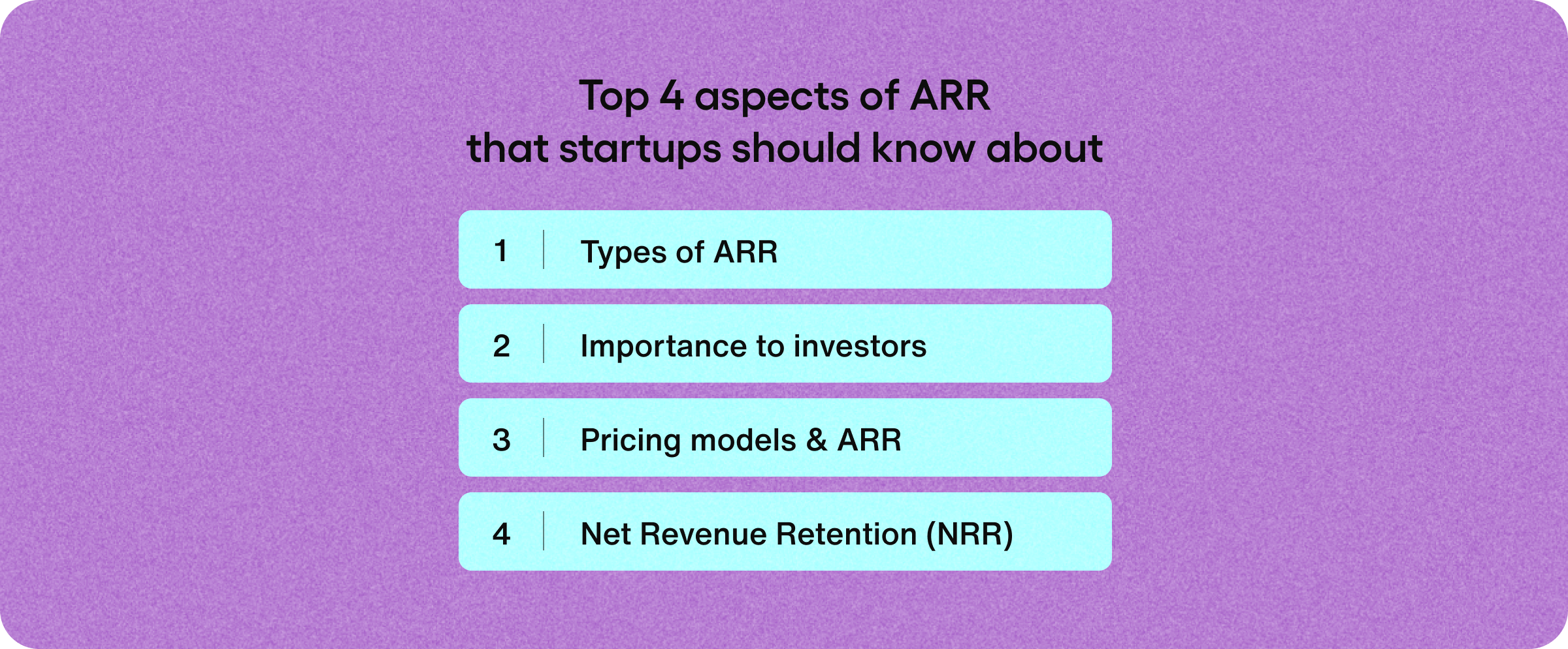
Note that ARR measures subscription-based revenue; this is why ARR is such a powerful metric for SaaS startups. It provides a clear picture of the company's revenue health by focusing on predictable, recurring income rather than one-time sales. This makes ARR crucial for assessing a subscription-based business model's sustainability and growth potential, helping startups understand how effectively they are retaining and expanding their customer base over time.
Types of ARR
SaaS startups should also recognize that ARR can be broken down into several components, such as new ARR, expansion ARR, and churned ARR. New ARR measures the revenue gained from acquiring new customers, expansion ARR accounts for additional revenue from existing customers (e.g., through upselling or cross-selling), and churned ARR represents lost revenue from customers who have canceled their subscriptions. By tracking these components, startups can identify growth drivers and areas that need improvement, such as reducing churn rates or increasing customer upsells.
Importance to investors
Furthermore, ARR plays a significant role in strategic decision-making, including valuation, fundraising, and forecasting. Investors often use ARR to evaluate a startup's market traction and growth potential, making it a critical metric to secure funding. Accurate ARR projections also enable startups to forecast future revenue more effectively, plan resources, and set realistic growth targets, which are essential for scaling the business sustainably.
Pricing models & ARR
Next, pricing models, such as tiered subscriptions, usage-based pricing, or freemium models, can significantly impact ARR growth. Startups should experiment with pricing strategies that align with customers' needs while maximizing lifetime value. Adjusting pricing strategies over time, based on customer feedback and market trends, can drive ARR growth by increasing customer acquisition, enhancing upsells, and reducing churn. Understanding the interplay between pricing and ARR helps startups optimize their revenue models for sustainable growth.
Net Revenue Retention (NRR)
While ARR is a critical indicator of revenue growth, SaaS startups should also measure Net Revenue Retention (NRR) to get a fuller picture of customer revenue dynamics. NRR accounts for expansions, contractions, and churn, indicating how much revenue is retained from existing customers. High NRR (over 100%) suggests that upsells and renewals outweigh churn, which is an indicator of healthy growth. Using NRR alongside ARR can help startups better assess customer value and revenue stability.
MRR vs. ARR
In a nutshell, MRR is the same as ARR, except measured over a month instead of a year. Monthly Recurring Revenue (MRR) is a key metric for subscription-based businesses, representing the predictable monthly income generated from customer subscriptions. It excludes one-time fees and focuses on the recurring revenue stream, providing a clear picture of a company's financial health and growth trajectory.

By understanding historical MRR growth and churn rates, product managers can create more accurate forecasts for future ARR. This allows for better resource allocation and planning for upcoming expenses.
For whom is annual recurring revenue (ARR) useful?
The Annual Recurring Revenue (ARR) model is most suitable for businesses with subscription-based revenue models, particularly in the Software as a Service (SaaS) industry. It is also applicable to companies in sectors such as media, telecommunications, and any service-based industries that offer renewable subscriptions or contracts. Start-ups and established companies alike use ARR to attract investors by demonstrating consistent revenue streams.
Furthermore, internal stakeholders, including executives and product managers, rely on ARR for strategic decision-making, financial forecasting, and resource allocation. Financial analysts and investors use ARR to assess company health, growth potential, and valuation. Any business seeking to understand its revenue stability, forecast future performance, and communicate its financial status to external parties should consider using the ARR model.
Top 6 strategies to increase ARR
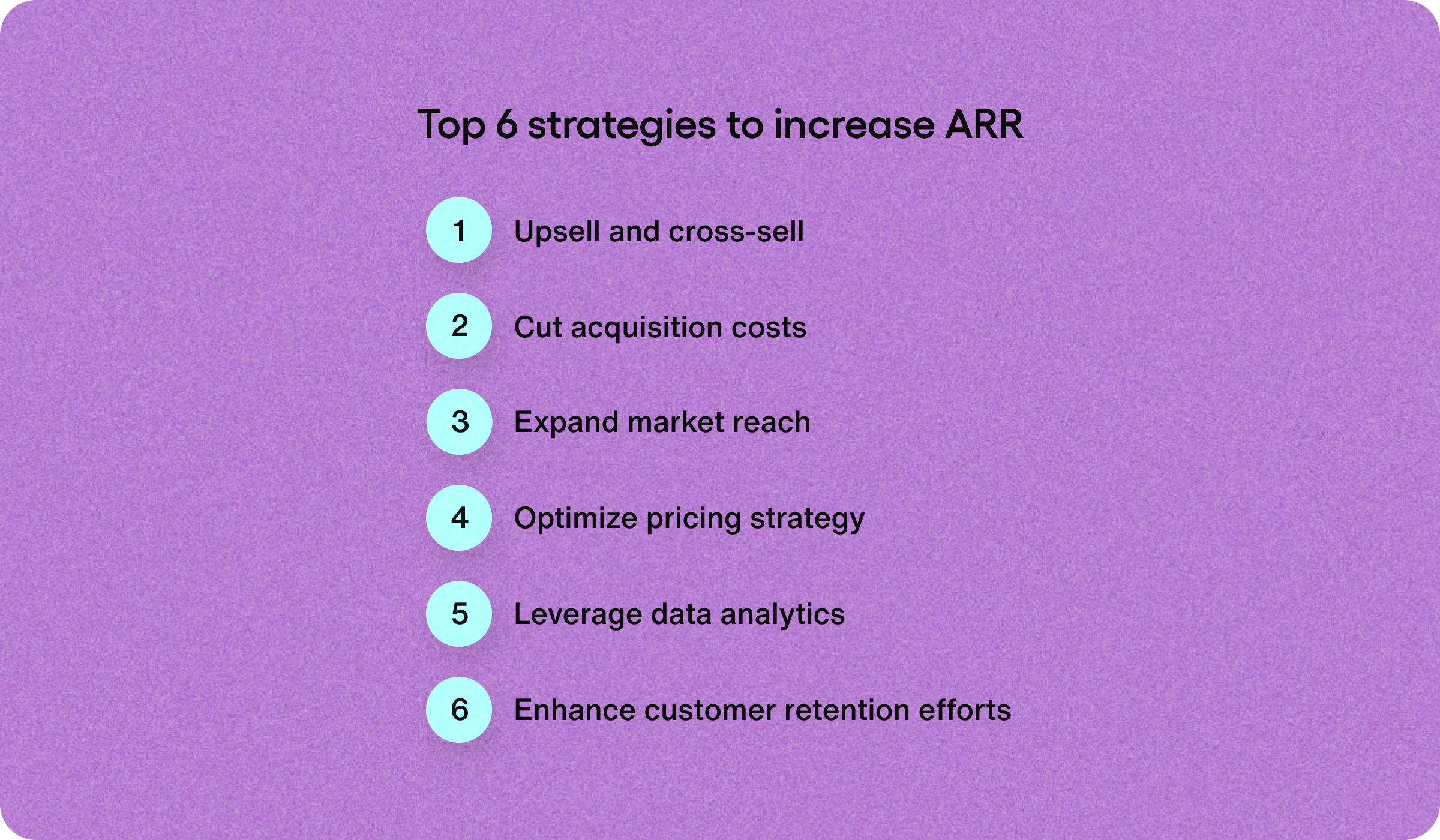
The more ARR your business can generate, the more leeway you have to scale and expand. After all, the ARR you generate ultimately determines your business’s growth prospects and valuations. Here are some actionable ways to increase your annual recurring revenue.
1. Upsell and cross-sell
Encourage existing customers to upgrade to higher-tier subscription plans or purchase additional features and services. This strategy not only increases revenue but also enhances customer engagement by providing solutions that more closely meet their needs.
2. Cut acquisition costs
Customer acquisition cost is the total spend on acquisition over a period divided by how the number of paying customers we acquired during that period. Reducing the customer acquisition cost, such as by keeping existing customers happy through loyalty programs, will keep more money in the bank, increasing your ARR.
3. Expand market reach
Target new customer segments or expand into new geographic markets. Broadening the customer base can significantly increase the number of active subscriptions contributing to ARR. This may also mean turning up marketing tactics to attract qualified leads and sharpening up sales to make sure they’re ready to close deals with all these new leads.
4. Optimize pricing strategy
Review and adjust pricing models to align better with customer value perception and market standards. This may involve introducing new pricing tiers, bundling products, or seasonal promotions that make subscriptions more appealing.
5. Leverage data analytics
Utilize analytics to gain insights into customer behavior, preferences, and product usage. This data can inform strategic decisions about product enhancements, marketing campaigns, and sales tactics that drive subscription growth and ARR enhancement.
6. Enhance customer retention efforts
Focus on reducing churn rates through improved customer service, regular engagement, and feedback loops. Ensuring customer satisfaction can lead to higher renewal rates, which directly impact ARR by maintaining a stable revenue base.
After all, happy customers are more likely to buy from your brand. Marigold’s 2024 global consumer trends index found that nearly 60% of consumers will pay more to purchase from a brand they like.
What breeds this retention? Great products or services, a friendly website and/or mobile app experience, and remarkable customer service. How can your mobile app deliver on these customer desires while simultaneously trying to cut costs and grow ARR?
One fantastic solution is to increase customer engagement with business communication technology in your app.
By launching customer engagement capabilities via Sendbird’s communications API platform. With Sendbird, you can send relevant, timely, omnichannel business messages (such as through push notifications, in-app notifications, SMS, KakaoTalk, and WhatsApp) and reinvent mobile customer communication.
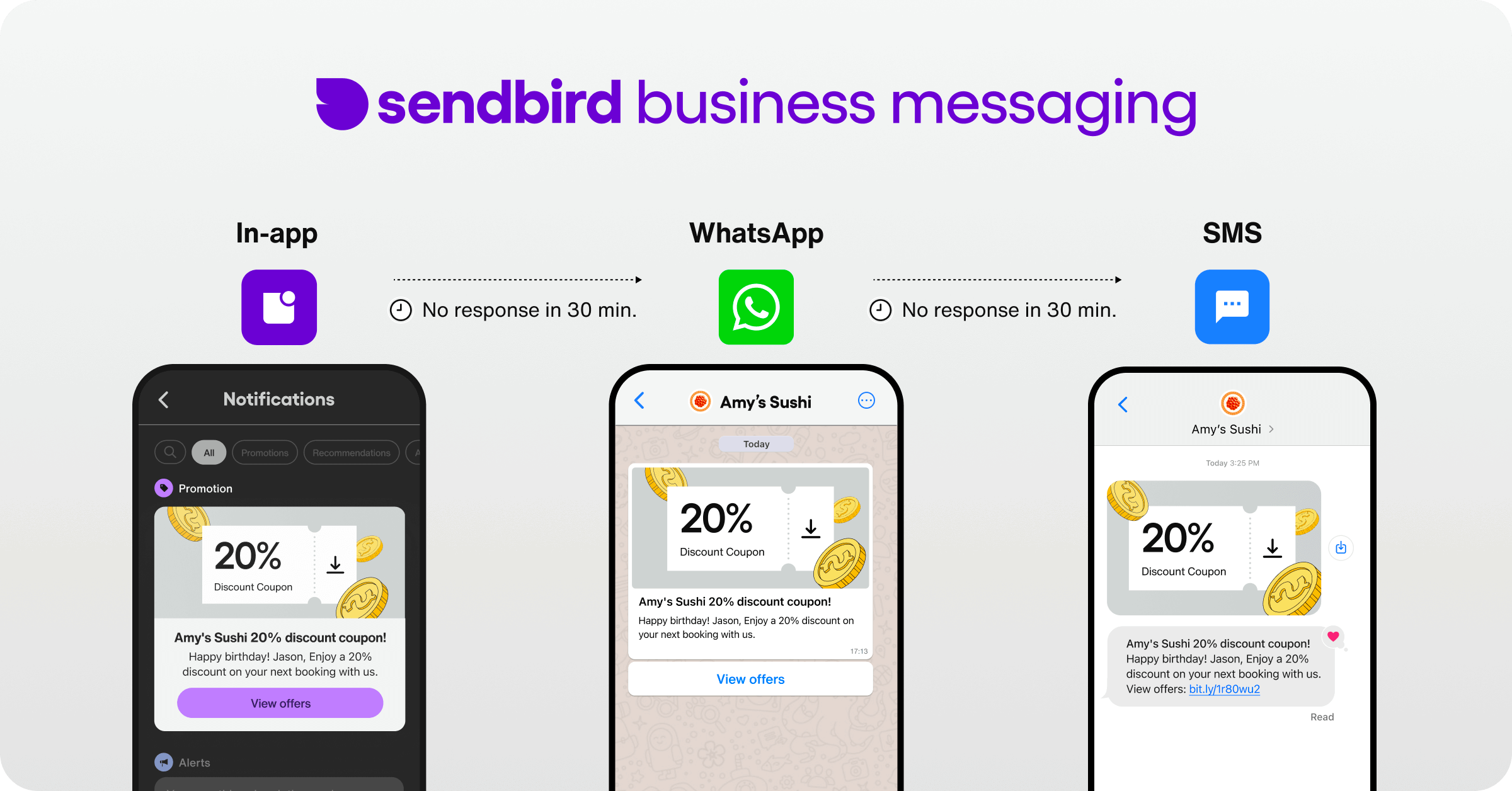

How to build the perfect mix of mobile customer communication channels
Another way to increase customer engagement is to build a custom AI chatbot for your website (in minutes!) to automate engagement, marketing, sales, and support with conversational AI. AI can also help you automate customer support, increase agent productivity, and boost customer satisfaction with a Salesforce Connector.
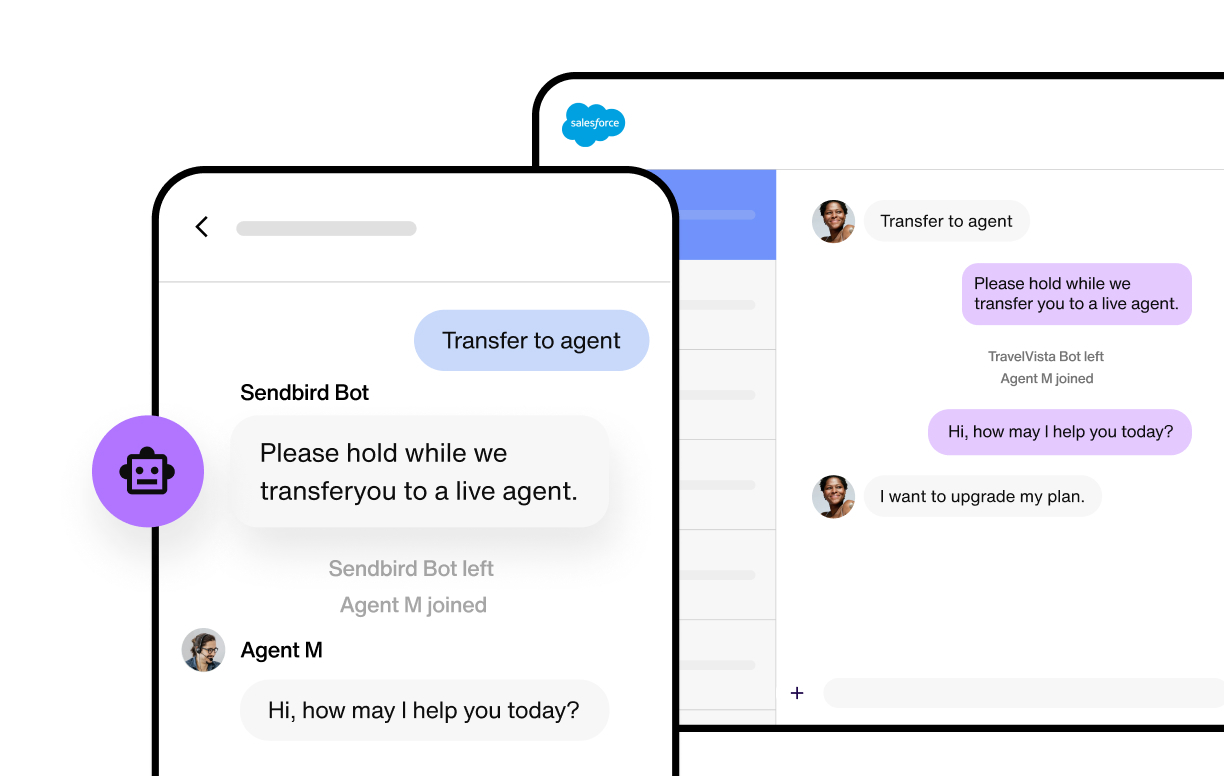
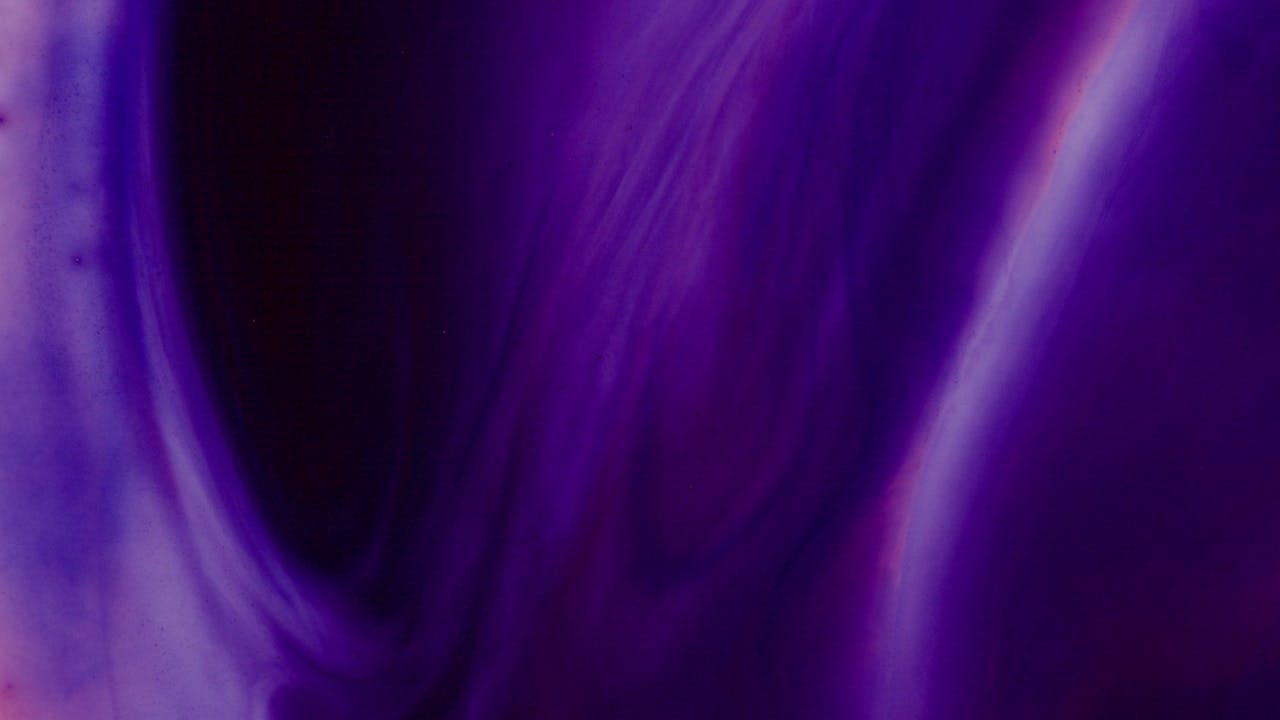
Empower your support agents with AI

Your app, your data. Drive engagement, conversion, & retention with the most trusted chat API.
Increase your annual recurring revenue (ARR) with a customer engagement platform
In this blog, we answered the question “What is ARR?”, discussed how to calculate ARR, and also looked at an ARR calculation example. We took a peek at the top 6 strategies to increase ARR and discussed a great way to increase ARR by increasing user engagement with a leading communications API platform like Sendbird.
To implement amazing customer engagement capabilities in your app, start a free trial (no commitment or credit card required) or contact us today to learn more!










